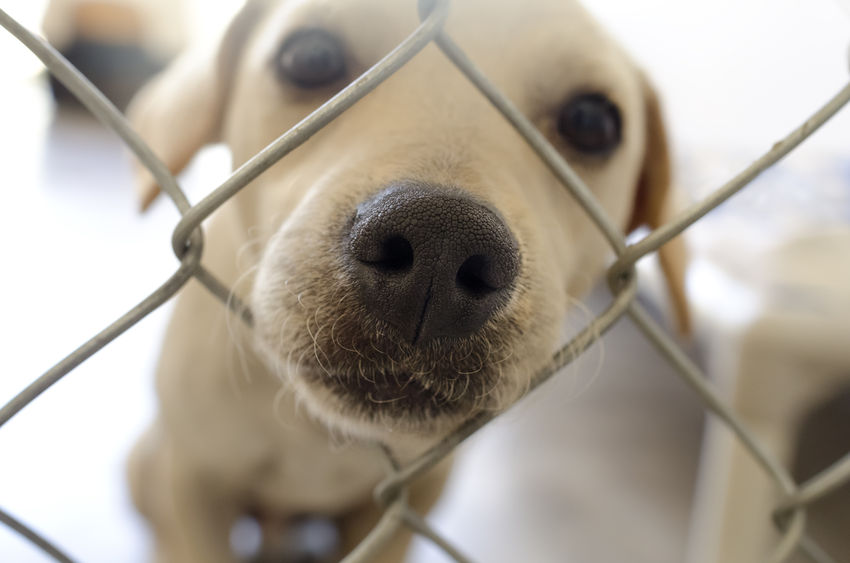A dog fence is a high quality fence that keeps your pet on your property and excludes intruding people and animals from accessing your pet’s designated area. There are many options to choose from with advantages and disadvantages to each kind. Selecting the fence that’s best for you will depend on your personal taste and aesthetic, your dog’s needs, your budget and what works best on your property. The types of fencing to consider include:

Solid Barrier Fences
Privacy Dog fences made with wood, metal, vinyl, and other solid materials work great for dogs that are easily distracted by other animals, kids, or neighbor dogs. These are made with solid panels so the dog can’t easily see through them. Privacy fences also add privacy, curb appeal, and overall value to your home. A fence like this contains and protects your dog and other neighborhood pets and small children that could wander in from the street or neighbors’ yards.
Are you looking for a fence that does double duty? A privacy fence can contain your dog and provide you with increased privacy from your neighbors. These fences are tall enough that the average person walking by can’t see over the fence. Dog owners can deter dogs from jumping over the top of a fence by building it high enough (about 4–6 feet high depending on the size of your dog) and angling the top at a 45 degree angle so they’re more likely to fall back down if they try to jump. If you decide to install a tall privacy fence, check local building laws. Some neighborhoods, municipalities, and cities have limits on how tall of a fence you can build.
If you want to build a privacy fence on your property, consider the size of your yard. This fence tends to have a more solid feel and can look overwhelming in more congested areas. It works better on larger properties that can support the solid and large feel of the fence.
Wooden Fences
A wooden fence is a classic and ideal choice for your back yard, especially if your dog is likely to bark or growl at people, animals and cars that pass by. The wooden fence can be solid or board on board – this will block the view of the street and the neighbor’s yard. The dog may be disrupted by hearing animals or children, but they won’t be able to see them with this kind of fence.
Wooden dog fences can also come with a high price tag and putting them up yourself is a time-consuming project, especially if your property is large. Some pet owners also have trouble with their larger dogs digging under fences. To discourage your dog from digging, you can install underground barriers or apply natural dog repellent sprays made of things like vinegar or cayenne pepper which some people report can be a useful solution.
Make your yard more dog-friendly if you use a material like wood, PVC, or picket fencing by installing a plexiglass viewing window or a fort in the middle of the yard so the dog can climb up and see and smell what’s happening over the fence.
Vinyl Fences
Vinyl fences are durable, they will not split, twist, warp, rust, or rot. Vinyl fences long lasting and are stronger and more flexible than wood. It can support more weight and force which is important for those with larger dog breeds who likes to jump. Vinyl is easy to clean off dirty paw prints and nose marks. Soap and a hard spray of water will easily get dirt and mud off.
A vinyl fence can give you privacy and create a modern, clean-looking fence that your dog can not see through. Like other privacy fences if your dog isn’t stranger-friendly or tends to bark at things they see. These fences are typically tall and have solid panels between the posts. You could have a plain top or choose a decorative lattice design.
Building a privacy fence will keep your dog contained and keep other people and animals out of your yard. They provide privacy, don’t require training to protect your pet and are great for smaller yards. A fence adds curb appeal to your property.
A privacy dog fence can be a costly and time consuming option. It’s labor intensive, it isn’t portable and isn’t appropriate for every kind of terrain. Regular maintenance is required and monitoring to make sure your dog isn’t working on an escape plan like digging under, biting through or breaking down the fence.
Chain Link Fences for dogs
Chain link fencing is an economical, low-cost and low-maintenance choice for enclosing a dog’s back yard. With a typical installation, these fences provide the least security and privacy. Your dog will be able to see out and interact with those passing by. These are easy to see through, so if you’re worried that your dog may become agitated by what they can see beyond the fence, you can grow vines through it with foliage that will block their view, or plant dense shrubbery on the inside of the fence to obstruct your pet’s view.
For a quicker solution, there are plastic or fabric strips that can be woven through chainlink fence gaps that effectively block the view from both sides.
The cheapest and easiest fence to build is a chainlink or wire fence. The advantages of these fences are that they require minimal to no maintenance. A chain link dog fence is a cheaper option for dog owners that want the benefits of a sturdy, long lasting enclosure, but not the high cost of materials like solid barrier fences. For an average sized yard, they can be be installed in a few hours by a professional.
We want to give our pets the freedom to run, play, and enjoy the best dog’s life. We are also fiercely protective of our canine companions. If you have a home with a large backyard, a properly fenced in area is important for safeguarding the beloved family pet. There are so many different styles, materials and types of fencing available today, you can secure your pet while simultaneously maintaining the look you want that fits the style of your home.
The best dog fences enhance your backyard space, keep the outside world out and your curious pooch in. Many fences are targeted towards solving specific pet problems like keeping those jumpter breeds from vaulting over the highest barriers, or thwarting the efforts of canines that are driven to tunnel their way out to freedom. The proper dog fence allows you and your pet can rest easy and play hard without constantly having to be on their tail while they are outside in the yard.
We want the best for our doggies, starting with a safe and loving home. All dogs, large or small, need to stretch their legs and enjoy the great outdoors. These dog fence ideas should help you decide how to increase your dog’s well being without sacrificing your home’s appeal.
